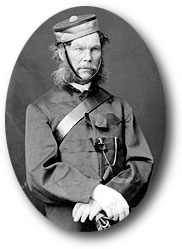
Some Background on Dr. Edward Van Cortlandt (1805 - 1875)Dr. Edward Van Cortlandt (also spelled van Cortlandt, Van Courtland) was one of Bytown's first citizens and a very colourful individual. In addition to being a medical doctor, he also had a great interest in a wide range of natural phenomena. In an unpublished biography, Margaret Moffat relates how Van Cortlandt's home at the intersection of Bay and Wellington Streets once housed "the best private archaeological museum in Canada of that day" (Moffat 1973:15).
In 1853, the Bytown Mechanics' Institute and Athenaeum was reorganized and on March 19, 1853 (for a more detailed history of the Bytown Mechanics Institute and Athenaeum, see Hirsch 1992), Dr. Edward Van Cortlandt presented the new Institute's first lecture: "the Phenomena of Vegetation". In 1865, he is named a life member of the Institute. The Institute maintained both a library and a newsroom. These, along with the public lectures, were central to their activities, allowing members to stay abreast of current affairs from across the country and a broad range of topics relating to the natural world (which included archaeology) (see Kapches 1994 for a discussion of the place of learned societies in the XIXth century world and Dyck 2001 for a sense of their impact in Canada in particular). Additionally, the Institute maintained a museum that appeared to gather mostly geological and biological specimens, but also antiquities of various types, including of course, native artefacts. Indeed, the published annual reports of the Institute often contain tantalizing clues of the richness and diversity of artefacts held in this Museum; everything from Egyptian idols, coins, stone gouges and chisels, an old French sword and an "Indian scalping knife". Clearly, artefacts were coming in to their collection from near and far. Several donations were noted over the years from the Renfrew area, but there were also native artefacts given by a Dr. J. Newton of Sault Ste-Marie. One can only imagine the task that the storage and display of a collection such as this must have represented. By 1869, the situation had deteriorated to such a point that "No addition has been made during the past year to the Museum; it remains as it was, exceedingly valuable, but almost perfectly useless, owing to the confined space in which so many specimens are huddled together without order or classification." (LAC n.d.a: vol. 2 Annual Report for 1869). While Van Cortlandt's formal participation in the Institute dropped off in the early to mid 1860's, his interest in intellectual pursuits did not. His obvious thirst for knowledge about the natural world appears as strong as ever because in 1863 the Natural History Society was founded. "We the undersigned being desirous to develop the Natural History of the Ottawa, and general resources of the surrounding country; Subscribe our names with a view to organize some association; whereby the different specimens in the various departments of natural history may be collected preserved and classed by some competent person and placed in a suitable room for exhibition. Oct. 3, 1863." Dr. Edward Van Cortlandt's name appears at the top of this list and his signature is the first one appended to the document. In October 1869, a joint committee of
representatives from the Bytown Mechanics' Institute and Athenaeum and
the Natural History Society recommended amalgamating the two societies and
by January, 1870 the Bytown Mechanics' Institute and Athenaeum was no
more. From this union was born the Ottawa Literary
and Scientific Society that would eventually be replaced by the Ottawa
Field Naturalists' Club in 1879 (formally incorporated as such in
1884). Interestingly, many artifacts from the
Ottawa area (currently in the collections of the Canadian Museum of
Civilization) were donated to the Geological Survey of Canada's museum
in the early 1880s (Figure 2).
The period labels which still adhere to many of these pieces indicate the gifts
were made by the Ottawa Literary and Scientific Society. Introduction |
Dr. Edward Van Cortlandt |
A Comparison of Two Articles |
